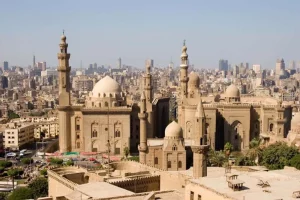Brief History of Islamic Egypt

Conquest of Egypt and the Foundation of el Fustat
Under the rule of the second Caliph of Islam, Omar Ibn Al Khatab, the Arab armies were organized to attack the Byzantine and Sassanid Empires. Under his rule, the Arab general Amr Ibn Al As overwhelmed the Byzantine forces in Egypt. Afterwards, they declared Egypt a part of the Islamic Caliphate. Egyptians native Copts adopted Islam for the simplicity and spontaneity of the Islamic faith. Later on, the Arabic language replaced the Coptic language slowly. Eventually, it spread to be the official language of Egypt till today.
The Umayyad Caliphs 661-750 AD
Although Damascus was the capital of Islamic Caliphate in the time of the Umayyad dynasty, Egypt was a very important country and principal part of the Islamic Caliphate in that time. Early agricultural and construction projects were done in Egypt. The most important one still is the Mosque of Amr in Al Fustat.
The Abbasid Caliphs 750-868 AD
With the end of the Umayyad dynasty, the new Abbasside Caliphate ruled from Baghdad. The first part of their rule is characterized by full power and flourishment in nearly all aspects of life and culture. Egypt was a prosperous Islamic state with stability and richness in Art and architecture. The second part of the Abbasside Caliphate,is known as the Weak age. Egypt was ruled by semi-independence rules from time to time, enjoying great wealth and prosperity, till the Ottoman Turks conquered Egypt (AD 1517). We can state some of these ruling houses and dynasties who ruled Egypt during the second time of the Abbasside Caliphate.
The Tulunids State 868-905
The Turkish officer Ahmad IbnTulun declared that Egypt was an independent governor from the Abbasid government in 868. He reigned for more than ten years and left a well-trained military, a stable economy. Then, he appointed his son Khumarawayh, as his heir. Further, the military and diplomatic achievements made him a major player in the Middle Eastern political stage. Also, the Abbasids confirmed that the Tulunids were legitimate rulers. His successors were ineffective rulers, as they were unable to resist the Abbasid invasion that restored direct caliph rule in Syria and Egypt.
The Ikhshidid 935-969 AD
The Abbasid Caliph appointed Muhammad Ibn Tughj Al-Ikhshid, a Turkicslave soldier, as the governor of Egypt. The dynasty carried the Arabic title “Wāli” reflecting their position as governors on behalf of the Abbasids. The Ikhshidids came to an end when the Fatimid army conquered Fustat in 969.
The Fatimid Cairo 969-1171 AD
Islam flourished during the early dynastic times specially the Ismaili Shia Fatimid dynasty who came originally from Tunisia. They conquered Egypt in 969 to establish its capital Cairo and the famous mosque Al-Azhar. From the tenth to the twelfth centuries, an area including Algeria, Tunisia, Sicily, Egypt, and Syria came under the rule of the Fatimid dynasty. The Fatimid conquered Egypt in 969 by General Gawhar Al Siquili for his ruler the Fatimid Caliph Al-Mu’izz Li-Din Ellah nearly with no war. Then the general Gawhar founded the city of Cairo (Al-Qahira, which means the Victorious) and established it as the new capital (973).
Soon Egypt enjoyed enormous prosperity in all aspects of life, art and culture during the Fatimid time. The opulence of the Fatimid court fueled a renaissance of handcrafts and the decorative arts. Consequently, it made Cairo the most important cultural center in the Islamic World. Furthermore, the great production of pottery, glass, metalwork, wood carving and textile factories run by government officials created fine fabrics. It spread the name of the caliph elsewhere in the Egyptian region. Both metalworkers and carvers demonstrated great skill in works created for and treasured by the caliphs themselves. The artwork from this period exemplifies the creativity and ingenuity of Fatimid craftsmen. The technique of lusterware on ceramic, developed originally in Iraq, was revived in Egypt. Wood carving, jewelry and lusterware pieces from this period signed by their makers underscore the esteem that such craftsmen acquired.
The Ayyubid Dynasty 1169-1252 AD
Egypt was ruled by the Kurdish general Salah Al-Din (Saladin. 1169–93), after repulsing a Crusader army that had reached the gates of Fatimid reign. Salah al-Din declared the end of the Fatimid Caliphate. Then he established the Ayyubid Sultanate (1171). As there was the danger of the Crusaders continued throughout the Ayyubid period; the Ayyubid kings were vigorous builders.
Their generous patronage led to tremendous architectural activity in Egypt and Syria. In Egypt Saladin built the Castle of the Mountain in 1179, (the actual citadel of Saladin in Cairo) and the Fort of Taba. He extended the Cairo walls and included inside the borders of Cairo the previous capitals of Egypt.
Saladin and his successors established madaras, higher institutions for religious learning, to spread the Sunni education after the Shiaa interlude in the region under the Fatimid. During the Ayyubid dynasty Egypt began to be a major cultural, political and social power in the Islamic world.
The Mamluks 1250-1517 AD
Apart from the middle of the century XIII, a military caste known as the Mamluks dominated the rule in Egypt. They established a powerful dynasty, turning Egypt to the major Islamic power. That happened when the kings of the Ayyubid dynasty, in the last years of their rule, depended on mamluks (slave soldiers) for its military organization. Furthermore, those who later took rule of the country, confirmed their right. Especially, when the Mongols destroyed Baghdad, they defended Egypt and the Islamic World and defeated the Mongols. Shortly afterwards, the Mamluk Sultan Baybars in Cairo installed an Abbasid Caliph in Cairo legitimizing the new Mamluk rule and expanded to Syria. Mamluk ruled Egypt and Syria from 1250 to 1517. Their descendants survived in Egypt as an important political force even after the Ottoman Conquest.
The Mamluks were great builders of military architecture. They carried out numerous renovations and expansions of previous Crusader and Ayyubid fortresses. The architects built primarily the architecture of the Mamluks of stone and predominant in the two major regions under their control: Egypt and Greater Syria. People used the wood for elements such as doors, panels and mihrabs, as well as for the lattice window screens known as mashrabiya. Stucco used for decorative elements.
More Tips
Dome shapes in Mamluk architecture often have a cylindrical drum and a pointed profile. The Mamluks used calligraphy extensively in decoration. Egypt, especially Cairo, was an important international political and commercial center in Mamluke time. As there were great movements of construction everywhere, especially Cairo like: mosques, Madrasas (schools), palaces, hospitals, mausoleum and markets. Cairo acquired some of its most impressive medieval architecture, including the historical monuments. Today, it defines the city’s architectural heritage.
With the Ottoman conquest, Egypt entered in a decadence period. Losing its economic and political independence for the Turkish with a period of internal disturbances and isolation. The three centuries of direct Ottoman rule in Egypt were a time of oppression and some historians. They described this period of rule as a dark age.
With the French conquest to Egypt led by Napoleon in 1798, it was the Renaissance of all life aspects. Also a situation spread during the rule of Muhammad Ali from 1845-1905. His reign set Islamic Egypt on the path to modernization.
Mohamed Ali reign and the Egyptian Monarchy
After the evacuation of the French Troops from Egypt 1801, The Egyptian began to rise up against the Ottoman ruler. Then for the first time they choose Mohamed Ali as their rules. Then, the Turkish Sultan approved and thus the young general Mohamed Ali nominated as Ruler of Egypt (governor or Wali). During his reign Egypt rebuilt and gained a powerful country.
He was the “father of modern Egypt,” who was able to attain control of Egypt. Likewise, he was able to modernize Egypt in many aspects of life because of his smart leadership. Mohamed Ali developed a very good strategy, based on agriculture reforms.
He expanded the area under cultivation. He also introduced planted crops specifically for export. For example, he planted long-staple cotton, sugarcane, indigo and rice. Muhammad Ali also committed to the industrial development of Egypt.
The government set up modern factories for weaving cotton, jute, silk, and wool. The government drafted Workers factories to weave on government looms. He also renovated the Education in Egyptian and all fundamental colleges as Medicine Schools.
During the reign of Mohamed Ali, Egypt was a powerful state in the Muslim world. For many centuries, Islamic Egypt has had a tremendous wealth of Islamic art and architecture. Cairo’s Islamic monuments are part of an uninterrupted tradition that spans over 1400 years of building activity. No other Islamic city can be equal to Cairo’s spectacular Islamic heritage.





